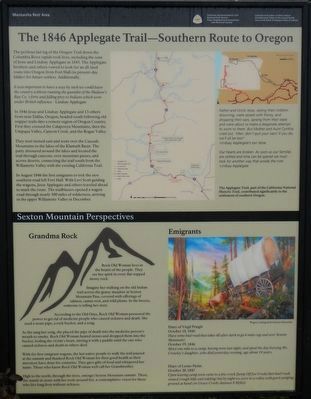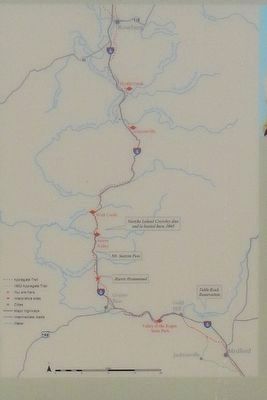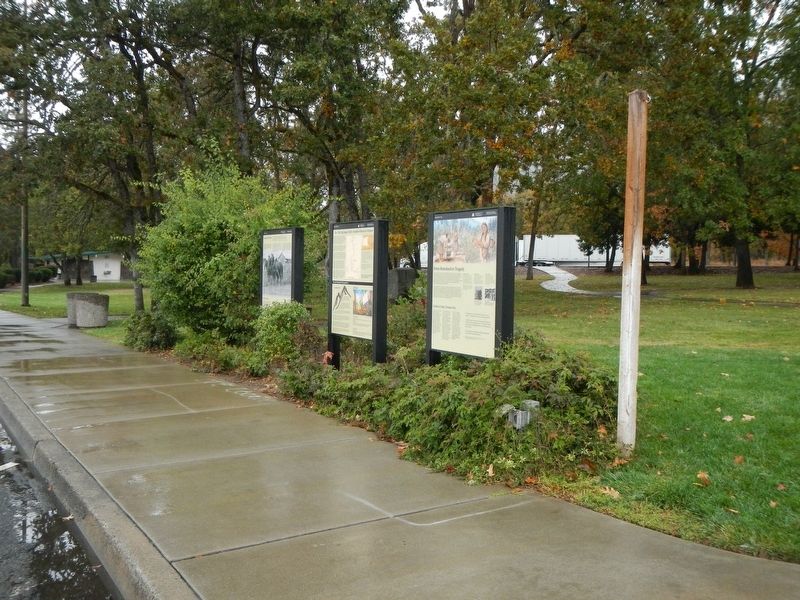Grants Pass in Josephine County, Oregon — The American West (Northwest)
The 1846 Applegate Trail
Southern Route to Oregon
It was important to have a way by such we could leave the country without running the gauntlet of the Hudson’s Bay Co.’s forts and falling prey to Indians which were under British influence. -Lindsay Applegate
In 1846 Jesse and Lindsay Applegate and 13 others from near Dallas, Oregon, headed south following old trapper trails into a remote region of Oregon Country. First they crossed the Calapooya Mountains, then the Umpqua Valley, Canyon Creek, and the Rogue Valley.
They next turned east and went over the Cascade Mountains to the lakes of the Klamath Basin. The party detoured around the lakes and located the trail through canyons, over mountain passes, and across deserts, connecting the trail south from the Willamette Valley with the existing California Trail.
In August 1846 the first emigrants to trek the new southern road left Fort Hall. With Levi Scott guiding the wagons, Jesse Applegate and others traveled ahead to mark the route. The trailblazers opened a wagon road through nearly 500 miles of wilderness, arriving in the upper Willamette Valley in December.
Father and Uncle Jesse, seeing their children drowning, were seized with frenzy, and dropping their oars, sprang from their seats and were about to make a desperate attempt to swim to them. But Mother and Aunt Cynthia cried out, ‘Men, don't quit your oars! If you do, we'll all be lost!’ -- Lindsay Applegate’s son Jesse
Our hearts are broken. As soon as our families are settled and time can be spared we must look for another way that avoids the river. -- Lindsay Applegate
Grandma Rock
Rock Old Woman lives in the hearts of the people. They see her spirit in every fiat-topped mossy rock.
Imagine her walking on the old Indian trail across the grassy meadow at Sexton Mountain Pass, covered with offerings of salmon, camas root, and wild plums. In the breeze, someone is telling her story.
According to the Old Ones, Rock Old Woman possessed the power to get rid of medicine people who caused sickness and death. She used a stone pipe, a rock bucket, and a song.
As she sang her song, she placed the pipe of death into the medicine person’s mouth to smoke. Rock Old Woman heated stones and dropped them into the bucket, boiling the victim’s heart, stirring it with a paddle until the one
who caused sickness and death in others died.
With the first emigrant wagons, the last native people to walk the trail paused at the summit and thanked Rock Old Woman for their good health as their ancestors have done for centuries. They gave gifts of food and whispered her name. Those who know Rock Old Woman well call her Grandmother.
High to the north, through the trees, emerges Sexton Mountain summit. There, she stands in stone with her tools around her, a contemplative vision for those who live long lives without sickness.
Diary of Virgil Pringle
October 18, 1846
Have some bad road that takes till after dark to go 6 miles (up and over Sexton Mountain).
October 19, 1846
Move one mile to a camp, having none last night, and spent the day burying Mr. Crowley’s daughter, who died yesterday evening, age about 14 years.
Diary of Lester Hulin
October 20, 1847
Upon leaving camp soon came to a fine creek [Jump Off Joe Creek] then bad roads ensued (rough hilly and sideling) but by night we were in a valley with good camping ground at hand (on Grave Creek) distance 8 M[ile]s
Erected by National Park Service, Hugo Neighborhood Association, Confederated Tribes of Siletz Indians, Confederated Tribes of the Grand
Ronde and Cow Creek Band of Umpqua Tribe of Indians.
Topics and series. This historical marker is listed in these topic lists: Native Americans • Roads & Vehicles • Settlements & Settlers. In addition, it is included in the Applegate Trail series list.
Location. 42° 31.014′ N, 123° 21.798′ W. Marker is in Grants Pass, Oregon, in Josephine County. Marker can be reached from Interstate 5 at milepost 62 near Merlin Road, on the right when traveling north. Touch for map. Marker is in this post office area: Grants Pass OR 97526, United States of America. Touch for directions.
Other nearby markers. At least 8 other markers are within 7 miles of this marker, measured as the crow flies. No Land is Free (a few steps from this marker); From Homeland to Tragedy (a few steps from this marker); Burrell M. Baucom (a few steps from this marker); Rogue River Wars (approx. 2.9 miles away); The Oregon Cavemen (approx. 4.3 miles away); The First Brick Building in Grants Pass (approx. 5.7 miles away); The Perkinsville Ferry (approx. 6.1 miles away); Fort Vannoy (approx. 6.2 miles away). Touch for a list and map of all markers in Grants Pass.
More about this marker. The marker is at the Manzanita Rest Area, Northbound, located about a mile north of the Grants Pass/Merlin Road exit #61.
Credits. This page was last revised on February 21, 2021. It was originally submitted on January 16, 2018, by Barry Swackhamer of Brentwood, California. This page has been viewed 461 times since then and 28 times this year. Last updated on February 21, 2021, by Carl Gordon Moore Jr. of North East, Maryland. Photos: 1, 2, 3. submitted on January 16, 2018, by Barry Swackhamer of Brentwood, California. • J. Makali Bruton was the editor who published this page.


